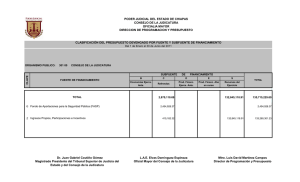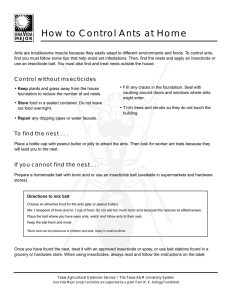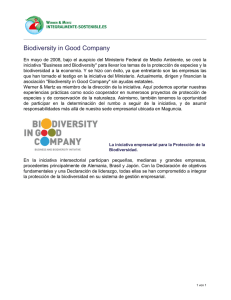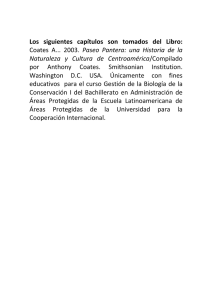en otra ventana
Anuncio
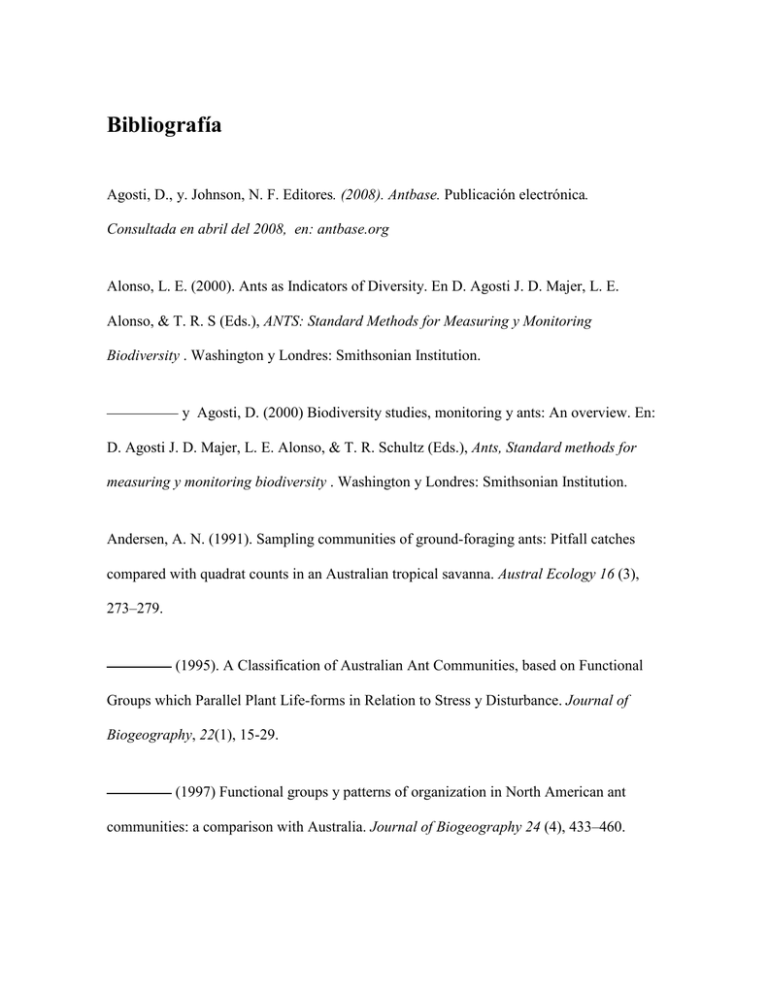
Bibliografía Agosti, D., y. Johnson, N. F. Editores. (2008). Antbase. Publicación electrónica. Consultada en abril del 2008, en: antbase.org Alonso, L. E. (2000). Ants as Indicators of Diversity. En D. Agosti J. D. Majer, L. E. Alonso, & T. R. S (Eds.), ANTS: Standard Methods for Measuring y Monitoring Biodiversity . Washington y Londres: Smithsonian Institution. y Agosti, D. (2000) Biodiversity studies, monitoring y ants: An overview. En: D. Agosti J. D. Majer, L. E. Alonso, & T. R. Schultz (Eds.), Ants, Standard methods for measuring y monitoring biodiversity . Washington y Londres: Smithsonian Institution. Andersen, A. N. (1991). Sampling communities of ground-foraging ants: Pitfall catches compared with quadrat counts in an Australian tropical savanna. Austral Ecology 16 (3), 273–279. (1995). A Classification of Australian Ant Communities, based on Functional Groups which Parallel Plant Life-forms in Relation to Stress y Disturbance. Journal of Biogeography, 22(1), 15-29. (1997) Functional groups y patterns of organization in North American ant communities: a comparison with Australia. Journal of Biogeography 24 (4), 433–460. (2000). Global ecology of rain forest ants: Functional groups in relation to environmental stress y disturbance. En D. Agosti J. D. Majer, L. E. Alonso, & T. R. Schultz (Eds.), Ants, Standard methods for measuring y monitoring biodiversity . Washington y Londres: Smithsonian Institution. y Majer, J.D. (2004). Ants show the way Down Under: invertebrates as bioindicators in land management. Frontiers in Ecology y the Environment, 2(6), 291-298. Antweb (2008). Adelomyrmex tristani. Consultado el 28 de abril del 2008, de: http://www.antweb.org/specimen.do?name=jtl0000115. Arcila, A. M., & Lozano-Zambrano, F. H. (2003). Hormigas como herramienta para la bioindicación y el monitoreo. En F. Fernández (Ed.), Introducción a las Hormigas de la Región Neotropical. Bogotá, Colombia: Instituto Alexander von Humboldt. Ausden, M. (1996). Invertebrates. En W. J. Sutherland (Ed.), Ecological Census Techniques. Avon, Gran Bretaña: Bath Press. Bestelmeyer, B.T., Agosti, D., Alonso, L.E., Brandao, C.R.F., Brown W.L. Jr., Delabie, J.H.C. y Silvestre, R. (2000). Field Techniques for the Study of Ground-Dwelling ants: An overview, description, y evaluation. En: D.Agosti, J.D. Majer, L.E. Alonsoy T.R. Schultz (eds). Ants: Standard methods for measuring y monitoring biodiversity. Washington y Londres: Smithsonian Institution. Bloom, S. A. (1981). Simmilarity Indices in Community Studies: Potential Pitfalls. Marine Ecology. Progress Series, 5(1), 125-128. Bolton, B. (1995). A new general catalogue of the ants of the world. Cambridge, Massachusetts: Harvard University Press. (1994). Identification guide to the ant genera of the world. Cambridge, Massachusetts, USA: Harvard University Press. (2003). Synopsis y Classification of Formicidae . Memoirs of the American Entomological Institute, 71, 370pp. Brown W. L. Jr. (1973). A comparison of the Hylean y Congo West African rain forest ant faunas. En: B. J. Meggers, E.S. Ayensu y W.D. Duckworth, (Eds). Tropical Forest Ecosystems in Africa y South América: A comparative review. Washington D.C.: Smithsoninan Institution Press. (2000) Diversity of ants. En D. Agosti J. D. Majer, L. E. Alonso, & T. R. Schultz (Eds.), Ants, Standard methods for measuring y monitoring biodiversity . Washington y Londres: Smithsonian Institution. Campos, D. (2001). Insectos. Boletín del Proyecto Insectos de Colombia, 1-11. Clarke, K. R. (1993). Non-parametric multivariate analysis of changes in community structure. Australian Journal of Ecology 18, 117-143. Costes-Quijano, R., Meza A.R., Macías-Juárez, A., Berriel-Mastreta, C.A., Cortés-Atilano, B., Martínez-Romero, L.E. y Hernández-Bautista, R. (2006) Plan de Manejo del Parque Ecológico Recreativo General Lázaro Cárdenas “Flor del Bosque”. Secretaría del Medio Ambiente y Recursos Naturales, Gobierno del Estado de Puebla, Puebla. EPA, Agencia de Protección al Ambiente de Estados Unidos, (2006). Terms of Environment: Glossary, Abbreviations y Acronyms . Citado el 15 de mayo de 2007, de http://www.epa.gov/OCEPAterms/dterms.html Flores-Maldonado, K.Y., Phillips, S.A. Jr., Sanchez-Ramos, G. (1999) The Myrmecofauna (Hymenoptera: Formicidae) along an Altitudinal Gradient in the Sierra Madre Oriental of Northeastern Mexico. The Southwestern Naturalist, 44 (4), 457-461 Gotelli, N. J., & Colwell, R. K. (2001). Quantifying Biodiversity: Procedures y Pitfalls in the Measurement y Comparision of Species Richness. Ecology Letters, 4(4), 379-391. y Entsminger, G.L. (2007). EcoSim: Null models software for ecology. Version 7. Acquired Intelligence Inc. & Kesey-Bear. Jericho, VT 05465. http://garyentsminger.com/ecosim.htm Graham J. H., Hughie H. H., Jones S., Wrinn K., Krzysik A.J., Duda J. J., et al. (2004). Habitat disturbance y the diversity y abundance of ants (Formicidae) in the Southeastern Fall-Line Sandhills. Journal of Insect Science, 4(30), 1-15. Hernández, P. H., Moreno, M. R., & Cortés, M. A. (1999). Enciclopedia de Municipios de México, Puebla. Amozoc. Consultado 28 de abril del 2008, de http://www.emexico.gob.mx/work/EMM_1/Puebla/Mpios/21015a.htm Hoffmann, B.D., & Andersen, A.N. (2003). Responses of ants to disturbance in Australia, with particular reference to functional groups. Austral Ecology, 28, 444-464. Hölldobler, B., y E.O. Wilson. (1990). The Ants. Cambridge, Massachusetts, USA: Belknap Press of Harvard University Press. Kaspari, M. (2000). A primer on ant ecology. En D. Agosti J. D. Majer, L. E. Alonso, & T. R. Schultz (Eds.), Ants, Standard methods for measuring y monitoring biodiversity. Washington y Londres: Smithsonian Institution. , y Majer, J. D. (2000). Using Ants to Monitor Environmental Change. En D. Agosti J. D. Majer, L. E. Alonso, & T. R. S (Eds.), ANTS: Standard Methods for Measuring y Monitoring Biodiversity. Washington y Londres: Smithsonian Institution. King, J. R., & Porter, S. D. (2005). Evaluation of Sampling Methods y Species Richness Estimators for Ants in Upland Ecosystems in Florida. Environmental Entomology, 34(6), 1566-1578. Krebs, C. J. (1989). Ecological Methodology . New York, NY: Harper Collins Publishers Inc Lattke, J. E. (2000). Specimen Processing: Building y Curating an Ant Collection. En D. Agosti J. D. Majer, L. E. Alonso, & T. R. S (Eds.), ANTS: Standard Methods for Measuring y Monitoring Biodiversity . Washington y Londres: Smithsonian Institution. (2003). Biogeografía de las hormigas neotropicales. En F. Fernández (Ed.), Introducción a las Hormigas de la Región Neotropical. Bogotá, Colombia: Instituto Alexander von Humboldt. Longino, J. T. (2000). What to do with the Data. En D. Agosti J. D. Majer, L. E. Alonso, & T. R. S (Eds.), ANTS: Standard Methods for Measuring y Monitoring Biodiversity . Washington Y Londres: Smithsonian Institution. Mackay, W. y E. Mackay. (1989). Clave de los géneros de hormigas en México (Hymenoptera: Formicidae). En Memorias del II Simposio Nacional de Insectos Sociales. Oaxtepec, Mor. México: SME- CIEAMAC. Magurran, A.E. (2005). Measuring biological diversity. Londres: Blackwell Publishing. Masaro, A. L., Souza, C. R., Della-Lucia, T. M., & Fernandes, J. B. (2004). Behavioural Changes in Workers of the Leaf-cutting Ant Atta sexdens rubripilosa induced by Chemical components of Eucalyptus maculata leaves. Journal of Chemical Ecology, 30(9), 17711780. Morrone, J. J. (2004). Panbiogeografía, componentes bióticos y zonas de transición. Revista Brasileira de Entomologia , 48(2), 149-162. Parra, A. V. (2005). Composición de la Mirmecofauna Epígea en un Gradiente Altitudinal de la Zona Centro de Veracruz (Tesis de Licenciatura). Puebla, Pue: Benemérita Universidad Autonoma de Puebla. , Flores, B., García, L., & Alba, L. (2003). Listado Mirmecofaunístico del Parque Zoológico Africam Safari. Elementos. Ciencia y Cultura BUAP, 52, 49-51. Presidencia de la República. (2000). Estrategia Nacional Sobre Biodiversidad de México. México: CONABIO. Consultado: 28 de abril del 2008, de: http://www.conabio.gob.mx/conocimiento/estrategia_nacional/doctos/pdf/ENB.pdf Quiroz-Robledo , L. N. (1999). Hymenoptera: Formicidae. Catálogo de Insectos y Ácaros Plaga de los Cultivos Agrícolas de México. Xalapa, Veracruz. México: Sociedad Mexicana de Entomología. Rice, E. L. (1984). Allelopathy (2a. ed.). Orlando (USA): Academic Press Rico-Gray, V., Garcia-Franco, J. G., Palacios-Ríos, M., Díaz-Castelazo, C. (1998a). Geographical y Seasonal Variation in the Richness of Ant-Plant Interactions in México. Biotropica, 30(2), 190-200. , Palacios-Ríos, M., García-Franco, J. G., & Mackay, W. P. (1998b). Richness and Seasonal Variation of Ant-Plant Associations Mediated by Plant-Derived Food Resources in the Semiarid Zapotitlán Valley, México. American Midland Naturalist, 140(1), 21-26. Ríos-Casanova, L., Valiente-Banuet, A., & Rico-Gray, V. (2004). Las Hormigas del Valle de Tehuacán (Hymenoptera: Formicidae): Una Comparación con otras Zonas Áridas de México. Acta Zoológica Mexicana (n.s.), 20(1), 37-54. , Valiente-Banuet, A., & Rico-Gray, V. (2006). Ant Diversity y its Relationship with Vegetation y Soil Factors in an Alluvial Fan of the Tehuacán Valley, México. Acta Oecologica, 29(3), 316-323. Rojas, P. (1996). Formicidae. En J. Llorente A. N. García-Aldrete, & E. González (Eds.), Biodiversidad de Artrópodos de México (Vol. I). México: UNAM-CONABIO. (2001). Las hormigas del Suelo en México: Diversidad, Distribución e Importancia (Hymenóptera: Formicidae). Acta Zoológica Mexicana Número especial 1, 189-238. Sarmiento-M, C. E. (2003). Metodologías de captura y estudio de las hormigas. En F. Fernández (Ed.), Introducción a las Hormigas de la Región Neotropical . Bogotá, Colombia: Instituto Alexander von Humboldt. Schultz, T.R. y McGlynn, T.P., (2000) The interactions of ants with other organisms. En Agosti D., Majer J.D., Alonso, L.E. y Schultz T.R. (Eds.) Ants: standard methods for measuring y monitoring biodiversity. Londres: Smithsonian Institution Press. Silvestre, R., Brandão, C. R., & Rosa da Silva, R. (2003). Grupos funcionales de hormigas: el caso de los gremios del Cerrado. En F. Fernández (Ed.), Introducción a las Hormigas de la Región Neotropical. Bogotá, Colombia: Instituto Alexander von Humboldt. Stephens, S. S. & Wagner, M. (2006). Using Ground Foraging Ant (Hymenoptera: Formicidae) Functional Groups as Bioindicators of Forest Health in Northern Arizona Ponderosa Pine Forests. Environmental Entomology, 35(4), 937-949. Tobin, J. E. (1995). Ecology y Diversity of Neotropical Rainforest Canopy Ants (Tesis Doctoral). Cambridge Massachusetts: Harvard University. Underwood, E.C. & Fisher, B.L. (2006). The role of ants in conservation monitoring: If, when, y how. Biological Conservation, 132, 166-182. Wang, C., Strazanac, J.S. & Butler L. (2001). Association Between Ants (Hymenoptera: Formicidae) y Habitat Characteristics in Oak-Dominated Mixed Forests. Environmental Entomology, 30 (5), 842-848. Wike, L. D., & Martin, F. D. (2005). Using Ant Communities for Rapid Assesment of Terrestrial Ecosystem Health. WSRC-TR-2005-00283, 1-6. Wilson, E. O. (1971). The Insect Societies. Cambridge, Massachusetts: Belknap Press of Harvard University Press. Zettler J.A., Taylor M.D., Allen, C. R., & Spira T.P. (2004). Consequences of Forest Clear-Cuts for Native y Nonindigenous Ants (Hymenoptera: Formicidae). Annals of the Entomological Society of America, 97(3), 513-518.
